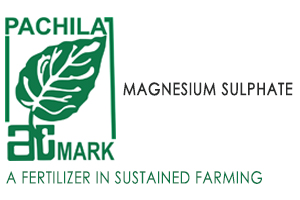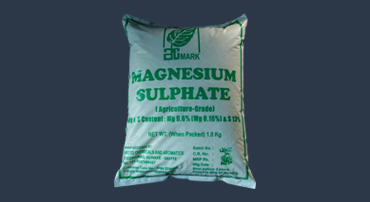
Magnesium sulphate is a chemical compound containing magnesium and sulphur with the formula MgSO4. It is often encountered as the heptahydrate, MgSO4•7H2O, commonly called Epsom salts. Magnesium sulphate is an ideal fertilizer for all crops. It is a source of Magnesium and Sulphur recognized as essential plant nutrients. It contains 16% Magnesium Oxide and 13% Sulphur in readily soluble form as required by plants like Nitrogenous, Phosphatic and Potassic fertilizers. However, Magnesium Sulphate signifies primarily the nutritional value of Magnesium which is a limiting factor in crop production.
Since over few decade Magnesium Sulphate has been popularly in use for various plantation and cash crops.
Hence all crops need to be fertilized with Magnesium Sulphate.
Followed by the green revolution the traditional agricultural practices are being replaced by modern technology and farm practices in India. Successful adoption of the new technology has led to continuous expansion in area under crops, total production and productivity. Our country has completed several five year plans and accorded the highest priority to agriculture as the country was faced with a serious food crisis and acute shortage of essential raw materials.
Under intensive cropping, nutritional requirement of crops need to be properly satisfied as the soil nutrients are depleted much more quickly. This necessitates the use of proper blend of all essential nutrients through integrated use of chemical fertilizers, manures, soil amendments etc. to maintain soil fertility and to sustain the tempo of growth in agricultural production for achieving agricultural production targets. The Magnesium level in the soil is very low.
The removal of magnesium along with sulphur by crops is as mentioned below
| Crop | Yield t/ha | Magnesium removal Kg. Mgo/ha | Crop | Yield t/ha | Magnesium removal Kg Mgo/ha |
| Alfalfa (hay) | 9 | 40 | Onion | 37 | 18 |
| Apple | 25 | 40 | Orange | 27 | 32 |
| Banana | 30 | 136 | Pepper (Black) | 2 | 25 |
| Barley | 5 | 26 | Pineapple | 30 | 90 |
| Bean (String Beans) | 24 | 40 | Potato | 30 | 29 |
| Cabbage | 70 | 57 | Radish | 40 | 30 |
| Carrot | 30 | 30 | Rape Seed | 2.5 | 26 |
| Cassava | 25 | 27 | Rice (Paddy) | 6 | 20 |
| Cocoa (dry beans) | 1 | 10 | Sorghum | 4 | 18 |
| Coconut | 38 | Rubber (Latex) | 1.5 | 4 | |
| Coffee (dry Cherries) | 2 | 33 | Soya bean | 2.5 | 30 |
| Cotton(lint) | 15 | 55 | Sugar Beet Sweet (Potato) |
40 20 |
90 44 |
| Cucumber | 20 | 42 | Tea (made tea) Sugar Cane |
2 1000 |
11 83 |
| Grapes Groundnut | 20 2 |
60 21 |
Tomato Tropical grasses (dry fodder) |
40 30 |
29 |
| Hops | 1 | 30 | Wheat | 5 | 105 |
| Oil palm (fresh fruit bunches) | 25 | 102 | Yam | 12 | 25 |
Note: 1 Kg. Mg = 1.658 Kg. Mgo = 10.3625 Kg. Magnesium Sulphate
| Crop | Yeild t/ha |
Sulphur removal Kg S/ha |
Crop | Yeild t/ha |
Sulphur removal Kg S/ha |
| Alfalfa | 9 | 24 | Onion | 40 | 25 |
| Banana | 30 | 13 | Orange | 50 | 30 |
| Barley | 5.4 | 22 | Pineapple | 40 | 16 |
| Bean | 1 | 25 | Potato | 30 | 15 |
| Cabbages | 35 | 47 | Rape Seed | 3 | 65 |
| Cassava | 19 | 8 | Rice (paddy) | 6 | 10 |
| Clover (hay) | 6-9 | 17-22 | Sorghum | 2.5 | 11 |
| Coco (2 ods) | 9 | 6 | Soya bean | 3 | 21 |
| coconut (9000 nuts) | 13 | Sugar beat | 40 | 32 | |
| Cotton (lint) | 1.5 | 30 | Sugar cane | 100 | 60 |
| Fodder beet | 45 | 45 | Sunflower | 4 | 18 |
| Groundnut | 2 | 15 | Table beet | 45 | 37 |
| Hope (Corymbs) | 1 | 30 | Tobacco | 3-4 | 13-2 |
| Maize | 4.5 | 26 | Tomato | 40 | 28 |
| Millet | 2.7 | 20 | Tropical grasses (dry fodder) |
27 | 60 |
| Oat | 3.6 | 22 | Turnip | 45 | 45 |
| Wheat | 5.4 | 28 | Oil palm | 18 | 20 |
Note: 100 Kg. Magnesium Sulphate = 13 Kg. Sulphur
The application of Magnesium Sulphate is generally recommended at the rate of 50 kg per acre during the time of fertilizers or according to the deficiency symptoms.

